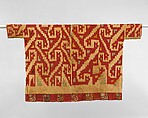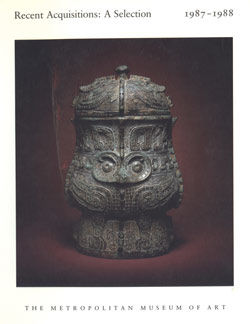Tunic
Not on view
Throughout Peruvian prehistory, the tunic was the most elaborate garment worn by men. In addition to being important items of dress, tunics are significant for their technical variety and their great wealth of complex patterning.
This example is strikingly bold in color. The main pattern, worked in red, represents interconnected, geometricized animals, whose serrated backs form strong diagonals across the body of the shirt. A border at the lower edge of the tunic (and originally at the sleeve ends as well), repeats a much smaller profile figure at regular intervals. Its long upraised tail has monkey references, but its long snout suggests that it is a composite animal. Such change of scale and the stylization of imagery from the center to the borders was common to textiles associated with the Huarmey Valley at this time. This variety was stimulated by external political and artistic forces as new influences moved into the area.
Due to rights restrictions, this image cannot be enlarged, viewed at full screen, or downloaded.


![Cochineal Red: The Art History of a Color [adapted from The Metropolitan Museum of Art Bulletin, v. 67, no. 3 (Winter, 2010)]](/-/media/images/art/metpublication/cover/2010/cochineal_red_the_art_history_of_a_color.jpg)
